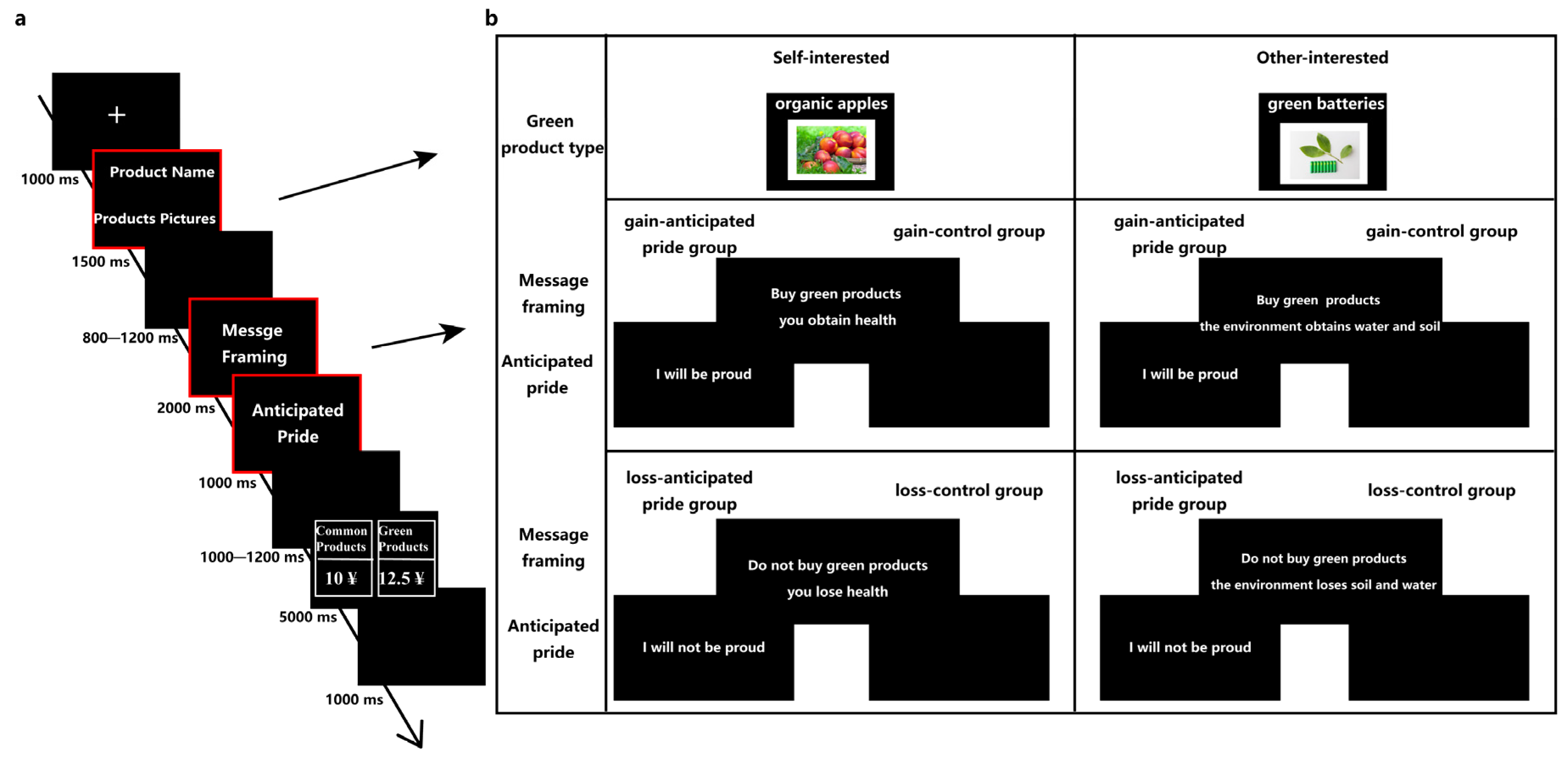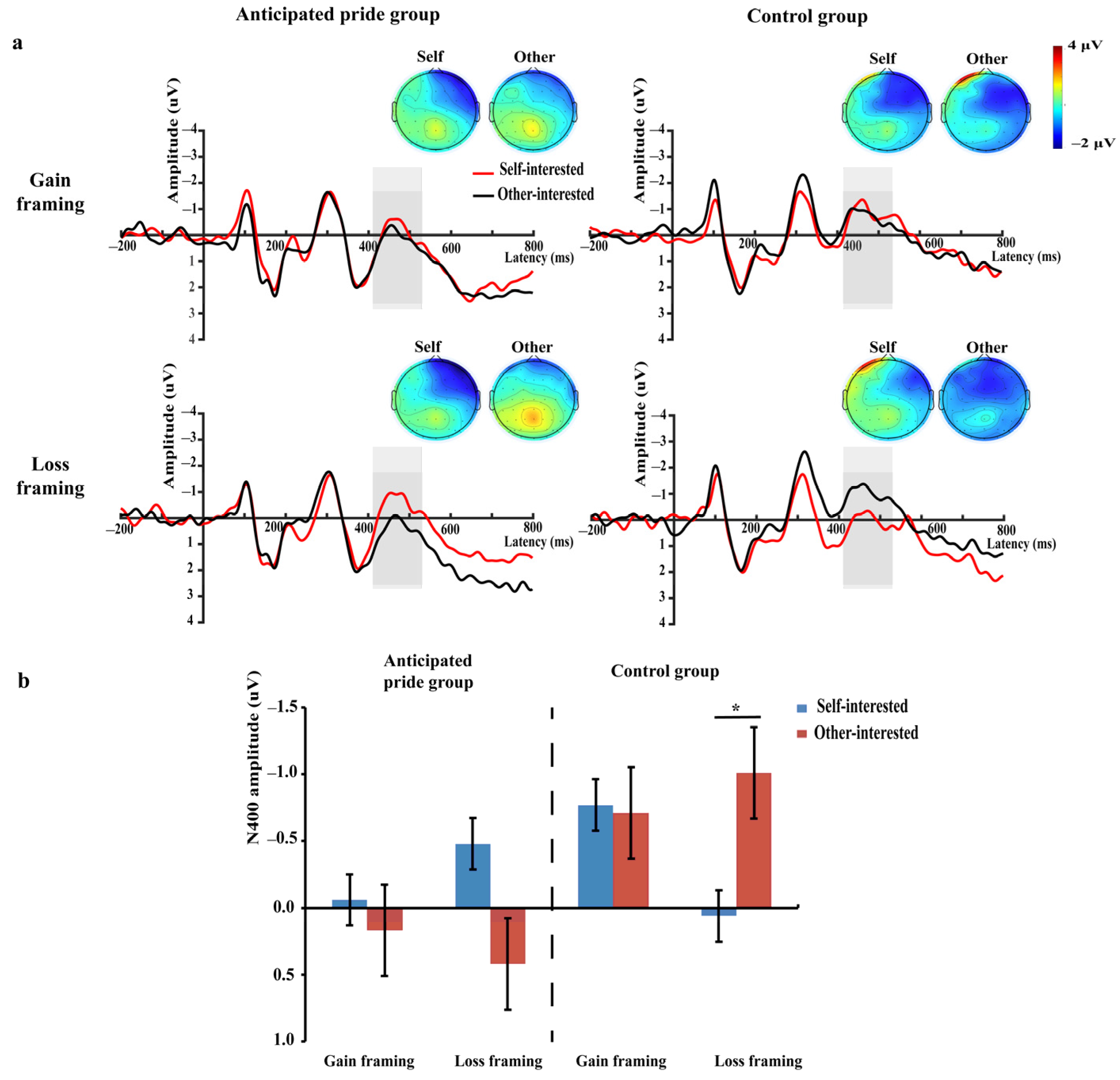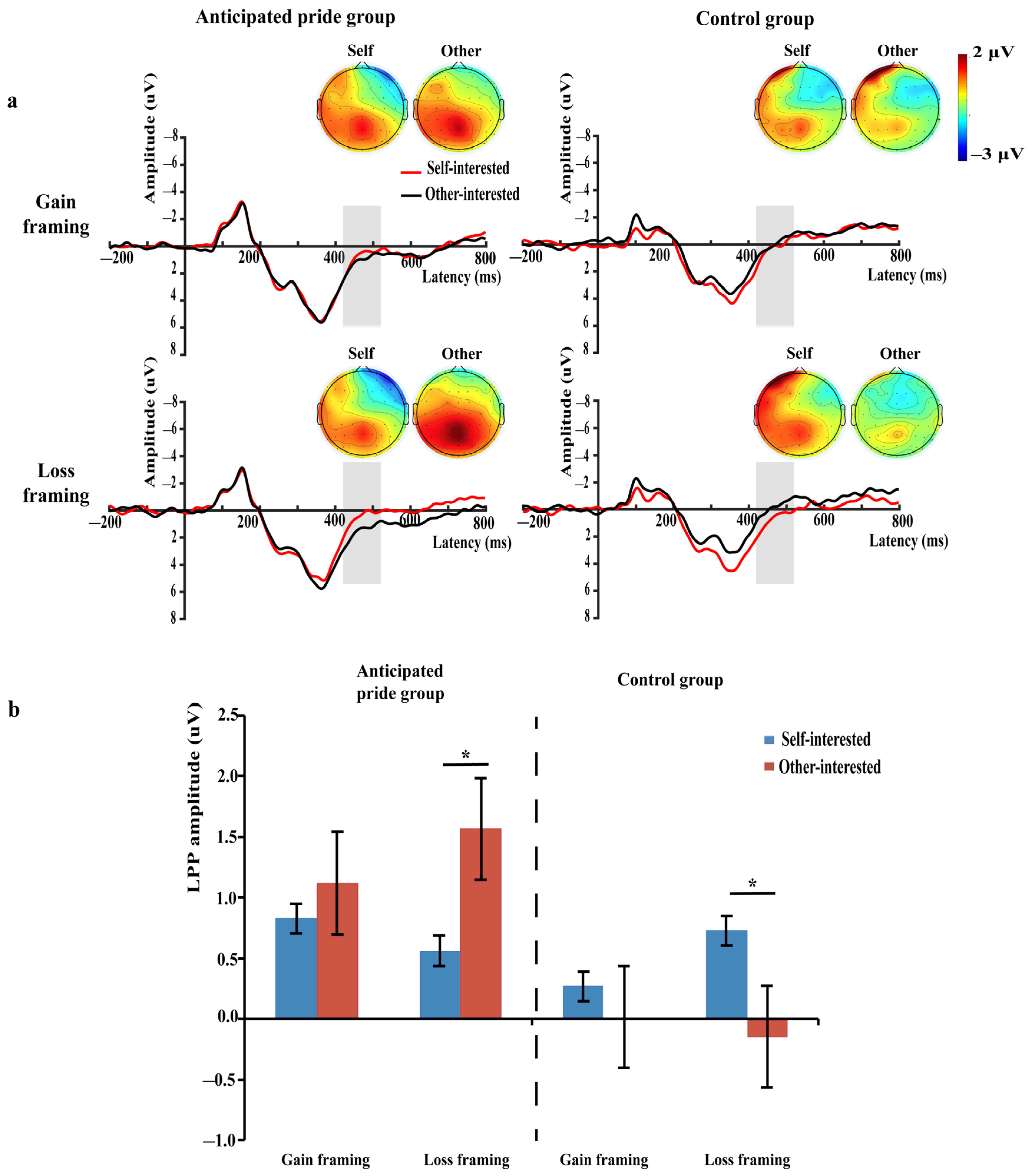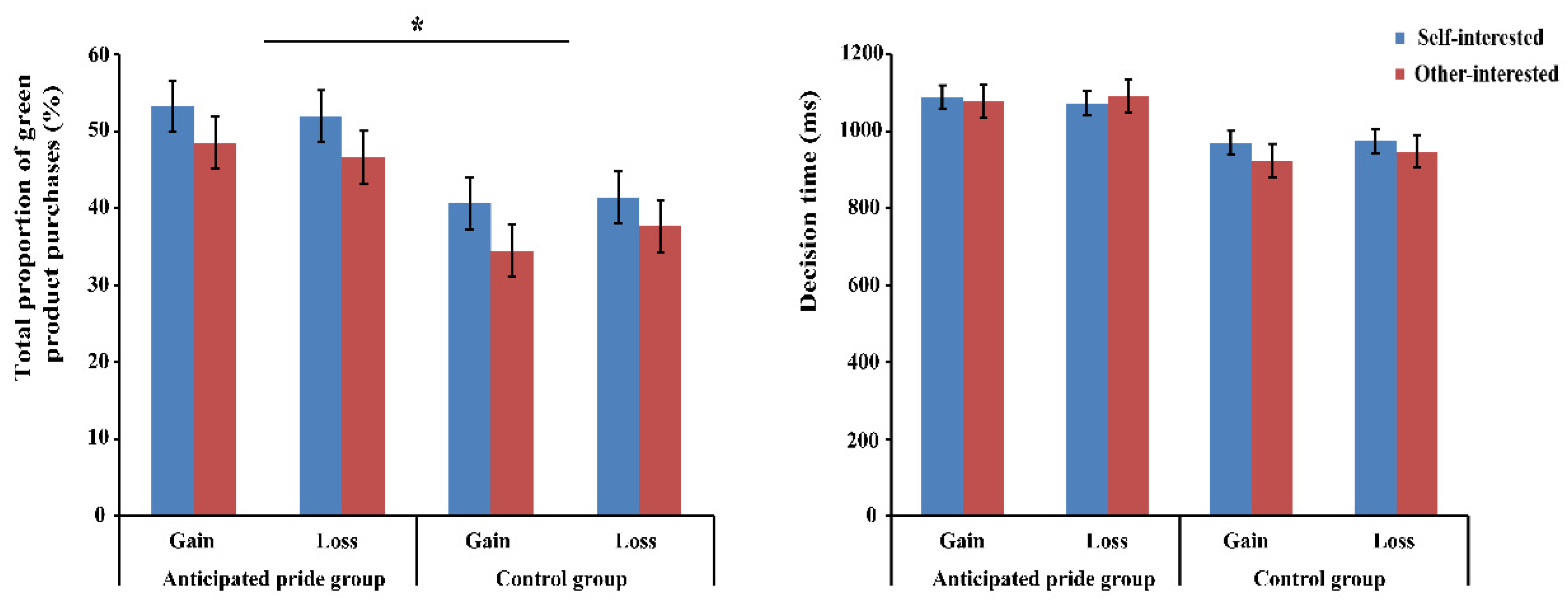The Influence of Green Product Type, Message Framing, and Anticipated Pride on Green Consumption Behavior: An Event-Related Potential (ERP) Study
Abstract
1. Introduction
| Model Name | Model Content | Features |
|---|---|---|
| Dual-system model (DSM) | It involves both cognitive and affective systems [25,26,27,28]. The cognitive system is contemplative, flexible, slow and strategic, centered on self-regulation and self-control, whereas the affective system is emotional, intuitive, fast and impulsive [25]. Both help individuals to make decisions. | Related to decision-making, includes cognitive and affective systems. |
| Dual-process model of approach and avoidance motivation | It has two motivational systems: the behavioral approach system (BAS) and the behavioral inhibition system (BIS). The BAS allows individuals to show approach motivation to positive cues such as rewards, non-punishment, and avoidance of punishment. The BIS causes individuals to develop avoidance motivation to avoid punishment [29,48,49]. | Related to behavioral motivation, includes BAS and BIS, inextricably linked to emotions. Approach motivation is associated with positive emotions. Avoidance motivation is associated with negative emotions. |
2. Materials and Methods
2.1. Participants and Experimental Design
2.2. Experimental Materials
2.2.1. Green Product Type Manipulation
2.2.2. Message Framing Manipulation
2.2.3. Anticipated Pride Manipulation
2.2.4. The Dilemma of the Environmental Decision Paradigm
2.3. Experimental Procedure
2.4. Electroencephalogram (EEG) Recording and Analysis
3. Results
3.1. Behavioral Results
3.2. ERP Results
3.2.1. P3 (315–415 ms)
3.2.2. N400 (410–530 ms)
3.2.3. LPP (420–520 ms)
4. Discussion
4.1. Green Consumption Behavior Is Influenced by Anticipated Pride
4.2. The P3 Is Modulated by Green Product Type and Anticipated Pride
4.3. The N400 and LPP Are Modulated by Green Product Type, Message Framing, and Anticipated Pride
4.4. Implications and Future Directions
5. Conclusions
Supplementary Materials
Author Contributions
Funding
Institutional Review Board Statement
Informed Consent Statement
Data Availability Statement
Conflicts of Interest
References
- Testa, F.; Pretner, G.; Iovino, R.; Bianchi, G.; Tessitore, S.; Iraldo, F. Drivers to green consumption: A systematic review. Environ. Dev. Sustain. 2020, 23, 4826–4880. [Google Scholar] [CrossRef]
- Pieters, R.G. Changing garbage disposal patterns of consumers: Motivation, ability, and performance. J. Public Policy Mark. 1991, 10, 59–76. [Google Scholar] [CrossRef]
- Wang, X.; Ming, M.; Zhang, Y. Are “people” or “animals” more attractive? Anthropomorphic images in green-product advertising. J. Clean. Prod. 2020, 276, 122719. [Google Scholar] [CrossRef]
- Yang, D.; Lu, Y.; Zhu, W.; Su, C. Going green: How different advertising appeals impact green consumption behavior. J. Bus. Res. 2015, 68, 2663–2675. [Google Scholar] [CrossRef]
- Wang, J.; Shen, M.; Chu, M. Why is green consumption easier said than done? Exploring the green consumption attitude–intention gap in China with behavioral reasoning theory. Clean. Responsible Consum. 2021, 2, 100015. [Google Scholar] [CrossRef]
- Lin, D.; Chen, H. A review of green consumer behavior based on the social perspective. Theor. Econ. Lett. 2016, 6, 1088–1095. [Google Scholar] [CrossRef]
- Wang, C.; Lei, L.; Wu, B. The attitude–behavior gap of ethical consumers: From the perspective of construal level. Adv. Psychol. Sci. 2017, 25, 511–522. [Google Scholar] [CrossRef]
- Wu, B. A Review on Green Consumption. Econ. Manag. J. 2014, 036, 178–189. [Google Scholar]
- Wang, C. Who would prefer to buy green products? Understanding green consumers. J. Psychol. Sci. 2019, 42, 1416–1421. [Google Scholar]
- Zhang, G.; Li, M.; Li, J.; Tan, M.; Li, H.; Zhong, Y. Green Product Types Modulate Green Consumption in the Gain and Loss Framings: An Event-Related Potential Study. Int. J. Env. Res. Public Health 2022, 19, 10746. [Google Scholar] [CrossRef]
- ElHaffar, G.; Durif, F.; Dubé, L. Towards closing the attitude–intention–behavior gap in green consumption: A narrative review of the literature and an overview of future research directions. J. Clean. Prod. 2020, 275, 122556. [Google Scholar] [CrossRef]
- Wyss, A.M.; Knoch, D.; Berger, S. When and how pro-environmental attitudes turn into behavior: The role of costs, benefits, and self-control. J. Environ. Psychol. 2022, 79, 101748. [Google Scholar] [CrossRef]
- Nguyen, H.V.; Nguyen, C.H.; Hoang, T.T.B. Green consumption: Closing the intention–behavior gap. Sustain. Dev. 2019, 27, 118–129. [Google Scholar] [CrossRef]
- Aldubai, O.A.; Develi, E.İ. Green Marketing and Its Impact on Consumer Buying Behavior. J. Int. Trade Logist. Law 2022, 8, 162–170. [Google Scholar]
- Druică, E.; Vâlsan, C.; Puiu, A.-I. Voluntary Simplicity and Green Buying Behavior: An Extended Framework. Energies 2022, 15, 1889. [Google Scholar] [CrossRef]
- Kim, N.; Lee, K. Environmental Consciousness, Purchase Intention, and Actual Purchase Behavior of Eco-Friendly Products: The Moderating Impact of Situational Context. Int. J. Env. Res. Public Health 2023, 20, 5312. [Google Scholar] [CrossRef]
- Ajzen, I.; Fishbein, M. Attitudinal and normative variables as predictors of specific behavior. J. Personal. Social. Psychol. 1973, 27, 41–57. [Google Scholar] [CrossRef]
- Armitage, C.J.; Christian, J. From attitudes to behaviour: Basic and applied research on the theory of planned behaviour. Curr. Psychol. 2003, 22, 187–195. [Google Scholar] [CrossRef]
- Ajzen, I. The theory of planned behavior: Frequently asked questions. Hum. Behav. Emerg. Technol. 2020, 2, 314–324. [Google Scholar] [CrossRef]
- Liu, H.S.; Li, J.X.; Song, M.J. Theoretical analysis and empirical test of the matching effect between green product and advertising appeals. Theory Pract. Financ. Econ. 2014, 35, 127–131. [Google Scholar] [CrossRef]
- Zhao, L.; Sun, J. Research on driving factors of green consume intention from the second order perspective of perceived value: The moderating effect of product categories. Econ. Forum 2020, 8, 121–133. [Google Scholar]
- Gong, S.; Sheng, G. Research on the influence mechanism of the effect of centrality of green attributes on consumer purchase intention: The moderating role of product type and the mediating effect of perceived benefit. J. Bus. Econ. 2021, 354, 52–64. [Google Scholar] [CrossRef]
- White, K.; MacDonnell, R.; Dahl, D.W. It’s the mind-set that matters: The role of construal level and message framing in influencing consumer efficacy and conservation behaviors. J. Mark. Res. 2011, 48, 472–485. [Google Scholar] [CrossRef]
- Amatulli, C.; De Angelis, M.; Peluso, A.M.; Soscia, I.; Guido, G. The Effect of Negative Message Framing on Green Consumption: An Investigation of the Role of Shame. J. Bus. Ethics 2019, 157, 1111–1132. [Google Scholar] [CrossRef]
- Cui, L.; Ye, M.; Sun, L.; Zhang, S.; He, G. Common and distinct neural correlates of intertemporal and risky decision-making: Meta-analytical evidence for the dual-system theory. Neurosci. Biobehav. Rev. 2022, 141, 104851. [Google Scholar] [CrossRef]
- Jahedi, S.; Deck, C.; Ariely, D. Arousal and economic decision making. J. Econ. Behav. Organ. 2017, 134, 165–189. [Google Scholar] [CrossRef]
- Lee, L.; Amir, O.; Ariely, D. In Search of Homo Economicus: Cognitive Noise and the Role of Emotion in Preference Consistency. J. Consum. Res. 2009, 36, 173–187. [Google Scholar] [CrossRef]
- Loewenstein, G.; O’Donoghue, T. Animal Spirits: Affective and Deliberative Processes in Economic Behavior. Working Paper, Available at Social Science Research Network, 2004. Available online: https://ssrn.com/abstract=539843 (accessed on 15 August 2023).
- Baek, T.H.; Yoon, S. Guilt and Shame: Environmental Message Framing Effects. J. Advert. 2017, 46, 440–453. [Google Scholar] [CrossRef]
- Koenig-Lewis, N.; Palmer, A.; Dermody, J.; Urbye, A. Consumers’ evaluations of ecological packaging—Rational and emotional approaches. J. Environ. Psychol. 2014, 37, 94–105. [Google Scholar] [CrossRef]
- Xu, J.Z.; Xie, X.F. Self-Other Decision Making Difference: A Construal Level Perspective. Acta Psychol. Sin. 2012, 43, 11–20. [Google Scholar] [CrossRef]
- Shipley, N.J.; van Riper, C.J. Pride and guilt predict pro-environmental behavior: A meta-analysis of correlational and experimental evidence. J. Environ. Psychol. 2022, 79, 101753. [Google Scholar] [CrossRef]
- Bissing-Olson, M.J.; Fielding, K.S.; Iyer, A. Experiences of pride, not guilt, predict pro-environmental behavior when pro-environmental descriptive norms are more positive. J. Environ. Psychol. 2016, 45, 145–153. [Google Scholar] [CrossRef]
- Hurst, K.F.; Sintov, N.D. Guilt consistently motivates pro-environmental outcomes while pride depends on context. J. Environ. Psychol. 2022, 80, 101776. [Google Scholar] [CrossRef]
- Leary, M.R. Motivational and emotional aspects of the self. Annu. Rev. Psychol. 2007, 58, 317–344. [Google Scholar] [CrossRef] [PubMed]
- Bagozzi, R.P.; Belanche, D.; Casaló, L.V.; Flavián, C. The Role of Anticipated Emotions in Purchase Intentions. Psychol. Mark. 2016, 33, 629–645. [Google Scholar] [CrossRef]
- Böhm, G.; Pfister, H.-R. Anticipated and experienced emotions in environmental risk perception. Judgm. Decis. Mak. 2008, 3, 73–86. [Google Scholar] [CrossRef]
- Schneider, C.R.; Zaval, L.; Weber, E.U.; Markowitz, E.M. The influence of anticipated pride and guilt on pro-environmental decision making. PLoS ONE 2017, 12, e0188781. [Google Scholar] [CrossRef]
- Haj-Salem, N.; Ishaq, M.I.; Raza, A. How anticipated pride and guilt influence green consumption in the Middle East: The moderating role of environmental consciousness. J. Retail. Consum. Serv. 2022, 68, 103062. [Google Scholar] [CrossRef]
- Mascolo, M.F.; Fischer, K.W. Developmental transformations in appraisals for pride, shame, and guilt. In Self-Conscious Emotions: The Psychology of Shame, Guilt, Embarrassment, and Pride; Guilford Press: New York, NY, USA, 1995; pp. 64–113. [Google Scholar]
- De Hooge, I.E.; Van Osch, Y. I Feel Different, but in Every Case I Feel Proud: Distinguishing Self-Pride, Group-Pride, and Vicarious-Pride. Front. Psychol. 2021, 12, 735383. [Google Scholar] [CrossRef]
- Dorfman, A.; Eyal, T.; Bereby-Meyer, Y. Proud to cooperate: The consideration of pride promotes cooperation in a social dilemma. J. Exp. Soc. Psychol. 2014, 55, 105–109. [Google Scholar] [CrossRef]
- Tangney, J.P.; Stuewig, J.; Mashek, D.J. Moral emotions and moral behavior. Annu. Rev. Psychol. 2007, 58, 345–372. [Google Scholar] [CrossRef] [PubMed]
- Green, T.; Peloza, J. Finding the Right Shade of Green: The Effect of Advertising Appeal Type on Environmentally Friendly Consumption. J. Advert. 2014, 43, 128–141. [Google Scholar] [CrossRef]
- Izuma, K.; Saito, D.; Sadato, N. Processing of the Incentive for Social Approval in the Ventral Striatum during Charitable Donation. J. Cogn. Neurosci. 2009, 22, 621–631. [Google Scholar] [CrossRef] [PubMed]
- Onwezen, M.C.; Bartels, J.; Antonides, G. The self-regulatory function of anticipated pride and guilt in a sustainable and healthy consumption context. Eur. J. Soc. Psychol. 2014, 44, 53–68. [Google Scholar] [CrossRef]
- Li, H.; You, C.; Li, J.; Li, M.; Tan, M.; Zhang, G.; Zhong, Y. Influence of Environmental Aesthetic Value and Anticipated Emotion on Pro-Environmental Behavior: An ERP Study. Int. J. Env. Res. Public Health 2022, 19, 5714. [Google Scholar] [CrossRef] [PubMed]
- Elliot, A.J. Approach and Avoidance Motivation. In Handbook of Approach and Avoidance Motivation; Psychology Press: New York, NY, USA, 2008; pp. 3–14. [Google Scholar]
- Shen, L.; Dillard, J.P. Message frames interact with motivational systems to determine depth of message processing. Health Commun. 2009, 24, 504–514. [Google Scholar] [CrossRef]
- LeDoux, J. The mental trilogy. In Synaptic self: How Our Brains become Who We Are; Viking: New York, NY, USA, 2002; pp. 174–199. [Google Scholar]
- Cain, C.K.; LeDoux, J.E. Brain Systems and Mechanisms: 2 Emotional Processing and Motivation. In Handbook of Approach and Avoidance Motivation; Psychology Press: New York, NY, USA, 2013; pp. 17–34. [Google Scholar]
- Li, J.; Li, M.; Sun, Y.; Fan, W.; Zhong, Y. Interpersonal relationships modulate subjective ratings and electrophysiological responses of moral evaluations. Cogn. Affect. Behav. Neurosci. 2022, 23, 125–141. [Google Scholar] [CrossRef]
- Vezich, I.S.; Gunter, B.C.; Lieberman, M.D. The mere green effect: An fMRI study of pro-environmental advertisements. Soc. Neurosci. 2017, 12, 400–408. [Google Scholar] [CrossRef]
- Li, M.; Li, J.; Li, H.; Zhang, G.; Fan, W.; Zhong, Y. Interpersonal distance modulates the influence of social observation on prosocial behaviour: An event-related potential (ERP) study. Int. J. Psychophysiol. 2022, 176, 108–116. [Google Scholar] [CrossRef]
- Jing, K.; Qi, M.; Mei, Y.; Chen, L. The impact of empathy with nature on green purchase behavior: An ERP study. Neurosci. Lett. 2022, 784, 136745. [Google Scholar] [CrossRef]
- Zubair, M.; Iqbal, S.; Usman, S.M.; Awais, M.; Wang, R.; Wang, X. Message framing and self-conscious emotions help to understand pro-environment consumer purchase intention: An ERP study. Sci. Rep. 2020, 10, 18304. [Google Scholar] [CrossRef] [PubMed]
- Li, J.; Sun, Y.; Li, M.; Li, H.E.; Fan, W.; Zhong, Y.P. Social distance modulates prosocial behaviors in the gain and loss contexts: An event-related potential (ERP) study. Int. J. Psychophysiol. 2020, 150, 83–91. [Google Scholar] [CrossRef] [PubMed]
- Li, M.; Li, J.; Zhang, G.; Fan, W.; Li, H.; Zhong, Y. Social distance modulates the influence of social observation on pro-environmental behavior: An event-related potential (ERP) study. Biol. Psychol. 2023, 178, 108519. [Google Scholar] [CrossRef] [PubMed]
- Nieuwenhuis, S.; Aston-Jones, G.; Cohen, J.D. Decision making, the p3, and the locus coeruleus-norepinephrine system. Psychol. Bull. 2005, 131, 510–532. [Google Scholar] [CrossRef]
- Polich, J.; Kok, A. Cognitive and biological determinants of P300: An integrative review. Biol. Psychol. 1995, 41, 103–146. [Google Scholar] [CrossRef]
- Chen, M.; Ma, Q.; Li, M.; Lai, H.; Wang, X.; Shu, L. Cognitive and emotional conflicts of counter-conformity choice in purchasing books online: An event-related potentials study. Biol. Psychol. 2010, 85, 437–445. [Google Scholar] [CrossRef]
- Wang, Q.; Meng, L.; Liu, M.; Wang, Q.; Ma, Q. How do social-based cues influence consumers’ online purchase decisions? An event-related potential study. Electron. Commer. Res. 2015, 16, 1–26. [Google Scholar] [CrossRef]
- Liu, J.; Mo, Z.; Fu, H.; Wei, W.; Song, L.; Luo, K. The Effect of Reviewers’ Self-Disclosure of Personal Review Record on Consumer Purchase Decisions: An ERPs Investigation. Front. Psychol. 2021, 11, 609538. [Google Scholar] [CrossRef]
- Hajcak, G.; MacNamara, A.; Olvet, D.M. Event-related potentials, emotion, and emotion regulation: An integrative review. Dev. Neuropsychol. 2010, 35, 129–155. [Google Scholar] [CrossRef]
- Pozharliev, R.; Verbeke, W.J.; Van Strien, J.W.; Bagozzi, R.P. Merely being with you increases my attention to luxury products: Using EEG to understand consumers’ emotional experience with luxury branded products. J. Mark. Res. 2015, 52, 546–558. [Google Scholar] [CrossRef]
- Hajcak, G.; Foti, D. Significance?& Significance! Empirical, methodological, and theoretical connections between the late positive potential and P300 as neural responses to stimulus significance: An integrative review. Psychophysiology 2020, 57, e13570. [Google Scholar] [CrossRef] [PubMed]
- Long, C.; Hu, X.; Qi, G.; Zhang, L. Self-interest is intuitive during opportunity (in)equity: Evidence from multivariate pattern analysis of electroencephalography data. Neuropsychologia 2022, 174, 108343. [Google Scholar] [CrossRef]
- Kim, B.M.; Lee, J.; Choi, A.R.; Chung, S.J.; Park, M.; Koo, J.W.; Kang, U.G.; Choi, J.S. Event-related brain response to visual cues in individuals with Internet gaming disorder: Relevance to attentional bias and decision-making. Transl. Psychiatry 2021, 11, 258. [Google Scholar] [CrossRef] [PubMed]
- Tracy, J.L.; Robins, R.W. The psychological structure of pride: A tale of two facets. J. Personal. Soc. Psychol. 2007, 92, 506–525. [Google Scholar] [CrossRef] [PubMed]
- Carver, C.S.; Johnson, S.L. Authentic and Hubristic Pride: Differential Relations to Aspects of Goal Regulation, Affect, and Self-Control. J. Res. Personal. 2010, 44, 698–703. [Google Scholar] [CrossRef]
- Cheng, J.T.; Tracy, J.L.; Henrich, J. Pride, personality, and the evolutionary foundations of human social status. Evol. Hum. Behav. 2010, 31, 334–347. [Google Scholar] [CrossRef]
- Huang, Y.; Kendrick, K.M.; Yu, R. Social conflicts elicit an N400-like component. Neuropsychologia 2014, 65, 211–220. [Google Scholar] [CrossRef]
- Van Berkum, J.J.; Holleman, B.; Nieuwland, M.; Otten, M.; Murre, J. Right or wrong? The brain’s fast response to morally objectionable statements. Psychol. Sci. 2009, 20, 1092–1099. [Google Scholar] [CrossRef]
- Lin, H.; Liang, J. ERP Effects of Malicious Envy on Schadenfreude in Gain and Loss Frames. Front. Hum. Neurosci. 2021, 15, 663055. [Google Scholar] [CrossRef]
- Bi, X.Y.; Ma, X.; Abulaiti, A.; Yang, J.; Tao, Y. The influence of pride emotion on executive function: Evidence from ERP. Brain Behav. 2022, 12, e2678. [Google Scholar] [CrossRef]
- Bi, X.Y.; Ma, X.; Tao, Y. The consistency of the influence of pride and shame on cognitive flexibility: Evidence from ERP. Neuroscience 2022, 487, 1–7. [Google Scholar] [CrossRef]
- Campbell, J.I.; Thompson, V.A. MorePower 6.0 for ANOVA with relational confidence intervals and Bayesian analysis. Behav. Res. Methods 2012, 44, 1255–1265. [Google Scholar] [CrossRef] [PubMed]
- Sullivan, M.D.; Janus, M.; Moreno, S.; Astheimer, L.; Bialystok, E. Early stage second-language learning improves executive control: Evidence from ERP. Brain Lang. 2014, 139, 84–98. [Google Scholar] [CrossRef] [PubMed]
- Cofresi, R.U.; Piasecki, T.M.; Hajcak, G.; Bartholow, B.D. Internal consistency and test-retest reliability of the P3 event-related potential (ERP) elicited by alcoholic and non-alcoholic beverage pictures. Psychophysiology 2022, 59, e13967. [Google Scholar] [CrossRef]
- Thigpen, N.N.; Kappenman, E.S.; Keil, A. Assessing the internal consistency of the event-related potential: An example analysis. Psychophysiology 2017, 54, 123–138. [Google Scholar] [CrossRef]
- Dominguez-Martinez, E.; Parise, E.; Strandvall, T.; Reid, V.M. The Fixation Distance to the Stimulus Influences ERP Quality: An EEG and Eye Tracking N400 Study. PLoS ONE 2015, 10, e0134339. [Google Scholar] [CrossRef]
- Li, Y.; Yang, D.; Liu, Y. The Effect of Message Framing on Consumers’ Intentions to Purchase Recycling-Aiding Products in China. Sustainability 2021, 13, 6966. [Google Scholar] [CrossRef]
- Florence, E.S.; Fleischman, D.; Mulcahy, R.; Wynder, M. Message framing effects on sustainable consumer behaviour: A systematic review and future research directions for social marketing. J. Soc. Mark. 2022, 12, 623–652. [Google Scholar] [CrossRef]
- Lee, Y.; Watchravesringkan, K. How to Promote Eco-Apparel? Effects of Eco-Labels and Message Framing. Int. J. Mark. Stud. 2022, 14, 1–69. [Google Scholar] [CrossRef]
- Zhong, Y.; Li, M.; Li, J.; Tan, M.; Fan, W.; Li, H. “Pursue Reputation for Profit”: The Influence of Social Observation and Social Distance on the Pro-environmental Behavior. J. Psychol. Sci. 2022, 45, 1398–1406. [Google Scholar]
- Carlson, R.W.; Aknin, L.B.; Liotti, M. When is giving an impulse? An ERP investigation of intuitive prosocial behavior. Social. Cogn. Affect. Neurosci. 2016, 11, 1121–1129. [Google Scholar] [CrossRef]
- Jung, D.; Sul, S.; Lee, M.; Kim, H. Social Observation Increases Functional Segregation between MPFC Subregions Predicting Prosocial Consumer Decisions. Sci. Rep. 2018, 8, 3368. [Google Scholar] [CrossRef]
- Plöchl, M.; Ossandón, J.P.; König, P. Combining EEG and eye tracking: Identification, characterization, and correction of eye movement artifacts in electroencephalographic data. Front. Hum. Neurosci. 2012, 6, 278. [Google Scholar] [CrossRef]
- Delorme, A.; Makeig, S. EEGLAB: An open source toolbox for analysis of single-trial EEG dynamics including independent component analysis. J. Neurosci. Methods 2004, 134, 9–21. [Google Scholar] [CrossRef] [PubMed]
- Chuang, Y.; Xie, X.; Liu, C. Interdependent orientations increase pro-environmental preferences when facing self-interest conflicts: The mediating role of self-control. J. Environ. Psychol. 2016, 46, 96–105. [Google Scholar] [CrossRef]
- Li, M.; Tan, M.; Wang, S.; Li, J.; Zhang, G.; Zhong, Y. The Effect of Preceding Self-Control on Green Consumption Behavior: The Moderating Role of Moral Elevation. Psychol. Res. Behav. Manag. 2021, 14, 2169–2180. [Google Scholar] [CrossRef] [PubMed]
- Katzir, M.; Eyal, T.; Meiran, N.; Kessler, Y. Imagined positive emotions and inhibitory control: The differentiated effect of pride versus happiness. J. Exp. Psychol. Learn. Mem. Cogn. 2010, 36, 1314–1320. [Google Scholar] [CrossRef] [PubMed][Green Version]
- Shimoni, E.; Berger, A.; Eyal, T. Priming pride promotes delay of gratification. Motiv. Emot. 2019, 43, 786–802. [Google Scholar] [CrossRef]
- Gould, S.J. An interpretive study of purposeful, mood self-regulating consumption: The consumption and mood framework. Psychol. Marketing. 1997, 14, 395–426. [Google Scholar]
- Taufik, D.; Bolderdijk, J.W.; Steg, L. Acting green elicits a literal warm glow. Nat. Clim. Change. 2014, 5, 37–40. [Google Scholar]
- Fishbach, A.; Eyal, T.; Finkelstein, S.R. How positive and negative feedback motivate goal pursuit. Soc. Personal. Psychol. Compass. 2010, 4, 517–530. [Google Scholar]
- Fishbach, A.; Labroo, A.A. Be better or be merry: how mood affects self-control. J. Personal. Soc. Psychol. 2007, 93, 158–173. [Google Scholar]
- Zhan, Y.; Xiao, X.; Tan, Q.; Li, J.; Fan, W.; Chen, J.; Zhong, Y. Neural correlations of the influence of self-relevance on moral decision-making involving a trade-off between harm and reward. Psychophysiology 2020, 57, e13590. [Google Scholar] [CrossRef]
- Fehr, E.; Fischbacher, U. Social norms and human cooperation. Trends Cogn. Sci. 2004, 8, 185–190. [Google Scholar] [CrossRef]
- Onwezen, M.C.; Bartels, J.; Antonides, G. Environmentally friendly consumer choices: Cultural differences in the self-regulatory function of anticipated pride and guilt. J. Environ. Psychol. 2014, 40, 239–248. [Google Scholar] [CrossRef]
- Crites, S.L.; Cacioppo, J.T.; Gardner, W.L.; Berntson, G.G. Bioelectrical echoes from evaluative categorization: II. A late positive brain potential that varies as a function of attitude registration rather than attitude report. J. Personal. Soc. Psychol. 1995, 68, 997–1013. [Google Scholar] [CrossRef]
- Jin, J.; Zhang, W.; Chen, M. How consumers are affected by product descriptions in online shopping: Event-related potentials evidence of the attribute framing effect. Neurosci. Res. 2017, 125, 21–28. [Google Scholar] [CrossRef] [PubMed]
- Ma, H.; Mo, Z.; Zhang, H.; Wang, C.; Fu, H. The Temptation of Zero Price: Event-Related Potentials Evidence of How Price Framing Influences the Purchase of Bundles. Front. Neurosci. 2018, 12, 251. [Google Scholar] [CrossRef] [PubMed]
- Sabatinelli, D.; Lang, P.J.; Keil, A.; Bradley, M.M. Emotional perception: Correlation of functional MRI and event-related potentials. Cereb. Cortex 2007, 17, 1085–1091. [Google Scholar] [CrossRef]
- Baumeister, R.F.; Vohs, K.D.; Nathan DeWall, C.; Zhang, L. How emotion shapes behavior: Feedback, anticipation, and reflection, rather than direct causation. Personal. Soc. Psychol. Rev. 2007, 11, 167–203. [Google Scholar] [CrossRef]
- Markus, H.R.; Kitayama, S. Culture and the self: Implications for cognition, emotion, and motivation. Psychol. Rev. 1991, 98, 224–253. [Google Scholar] [CrossRef]





Disclaimer/Publisher’s Note: The statements, opinions and data contained in all publications are solely those of the individual author(s) and contributor(s) and not of MDPI and/or the editor(s). MDPI and/or the editor(s) disclaim responsibility for any injury to people or property resulting from any ideas, methods, instructions or products referred to in the content. |
© 2023 by the authors. Licensee MDPI, Basel, Switzerland. This article is an open access article distributed under the terms and conditions of the Creative Commons Attribution (CC BY) license (https://creativecommons.org/licenses/by/4.0/).
Share and Cite
Zhang, G.; Li, J.; Tan, M.; Zhong, Y. The Influence of Green Product Type, Message Framing, and Anticipated Pride on Green Consumption Behavior: An Event-Related Potential (ERP) Study. Brain Sci. 2023, 13, 1427. https://doi.org/10.3390/brainsci13101427
Zhang G, Li J, Tan M, Zhong Y. The Influence of Green Product Type, Message Framing, and Anticipated Pride on Green Consumption Behavior: An Event-Related Potential (ERP) Study. Brain Sciences. 2023; 13(10):1427. https://doi.org/10.3390/brainsci13101427
Chicago/Turabian StyleZhang, Guanfei, Jin Li, Min Tan, and Yiping Zhong. 2023. "The Influence of Green Product Type, Message Framing, and Anticipated Pride on Green Consumption Behavior: An Event-Related Potential (ERP) Study" Brain Sciences 13, no. 10: 1427. https://doi.org/10.3390/brainsci13101427
APA StyleZhang, G., Li, J., Tan, M., & Zhong, Y. (2023). The Influence of Green Product Type, Message Framing, and Anticipated Pride on Green Consumption Behavior: An Event-Related Potential (ERP) Study. Brain Sciences, 13(10), 1427. https://doi.org/10.3390/brainsci13101427




